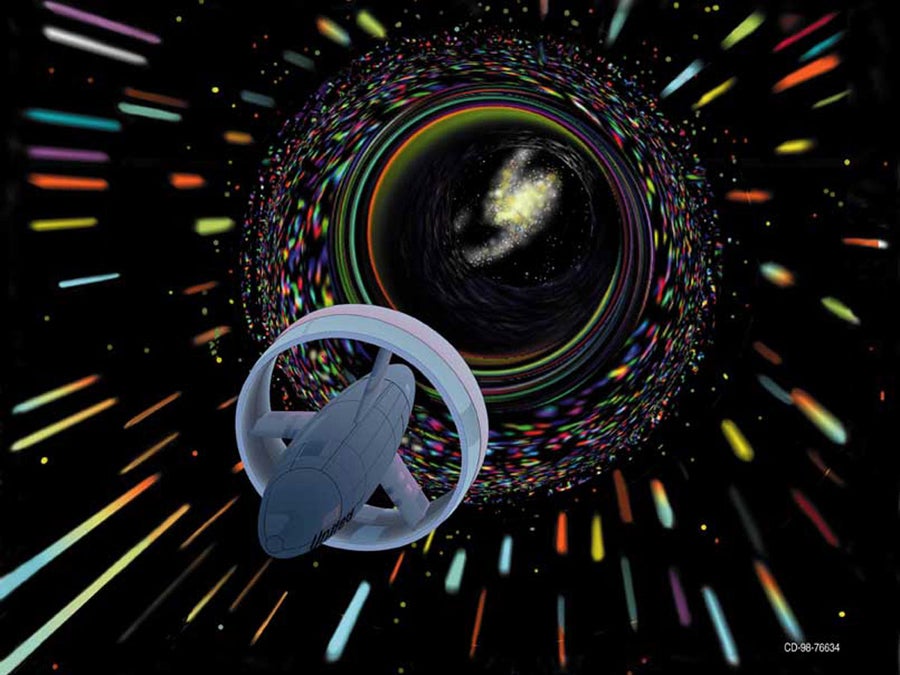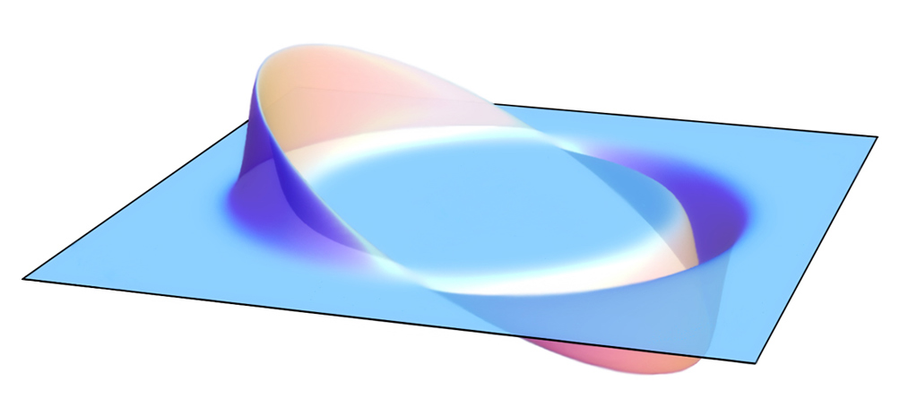For Erik Lentz, it all started with Star Trek. Every few episodes of Star Trek: The Next Generation, Captain Jean-Luc Picard would raise his hand and order, “Warp one, engage!” Then stars became dashes, and light-years flashed by at impossible speed. And Lentz, still in elementary school, wondered whether warp drive might also work in real life.
“At some point, I realized that the technology didn’t exist,” Lentz says. He studied physics at the University of Washington, wrote his Ph.D. dissertation on dark matter and generally became far too busy to be concerned with science fiction. But then, at the start of the coronavirus pandemic, Lentz found himself alone in Göttingen, Germany, where he was doing postdoctoral work. He suddenly had plenty of free time on his hands—and childhood fancies in his head.
Lentz read everything he could find on warp drives in the scientific literature, which was not very much. Then he began to think about it for himself. After a few weeks, something occurred to him that everyone else seemed to have overlooked. Lentz put his idea on paper and discussed it with more experienced colleagues. A year later it was published in a physics journal.
On supporting science journalism
If you're enjoying this article, consider supporting our award-winning journalism by subscribing. By purchasing a subscription you are helping to ensure the future of impactful stories about the discoveries and ideas shaping our world today.
It quickly became clear that Lentz was not the only person dreaming about warp drives. Media outlets all over the world picked up the story, and a dozen journalists asked for interviews. A discussion on the online forum Reddit attracted 2,700 comments and 33,000 likes. One Internet user wrote, “Anyone else feel like they were born 300 years too soon?”
A Bubble in Space and Time
There is no doubt that the universe is still far too vast for humans to traverse. It takes more than four years for a beam of light to reach Earth’s nearest star Proxima Centauri. Even with the best available propulsion systems, it would take tens of thousands of years for a human to get there. One can always dream about establishing colonies in other star systems, but it is not a journey anyone is likely to undertake.
But perhaps one day it might be possible to reduce the travel time. There are many ideas about how to do that, from laser-accelerated solar sails to nuclear propulsion. But even with the aid of these technologies, you would not get too far in a human lifetime. The galaxy really is open only to those who travel as fast as light—or faster.

NASA artist’s 1998 rendition of warp drive travel. The ring around the spacecraft generates a negative-energy field. From today’s perspective, the negative-energy field would no longer be necessary. Credit: NASA; Digital art by Les Bossinas (Cortez III Service Corp)
For that very reason, imaginative physicists have long been pondering the ultimate propulsion system: a bubble in space and time in which a spaceship could dash from sun to sun, just like the USS Enterprise did. This is research at the fringe of science: not necessarily wrong but spiced with a large pinch of optimism.
The fact that scientists are dealing with the idea at all today is thanks to a 1994 paper by Mexican theoretical physicist Miguel Alcubierre. At the time, Alcubierre was not just a passionate Star Trek devotee. In his doctoral thesis at the University of Wales College Cardiff (now Cardiff University), Alcubierre also worked on the theory of relativity. Strictly speaking, the theory states that nothing can travel faster than light. But by applying a little creativity, Alcubierre identified an apparent loophole.
For physicists, Albert Einstein’s theory of relativity consists of two parts: The “special” theory of relativity, which dates from 1905, deals with the uniform motion of fast-as-light objects. Ten years later Einstein generalized these ideas for accelerating bodies. According to “general” relativity, the three spatial dimensions we are familiar with (up-down, left-right, front-back) are inseparable from time. Every mass deforms this spacetime.
According to Albert Einstein’s epic discovery, we live in four-dimensional “spacetime.” Spacetime is not static. Like a tablecloth, it is deformed by massive objects. Everything that moves across the tablecloth (or through spacetime) can accelerate only up to the speed limit set by light. The tablecloth itself, on the other hand, can be deformed at any speed, as the universe itself shows in some situations.
At the instant of the big bang, for example, the original spacetime structure presumably expanded for a split second and did so much faster than any ray of light could travel. Even today, the expansion continues to drive extremely distant galaxies away at speeds faster than light, which means their light can no longer reach us.
Based on his discovery, Alcubierre surmised that it would only be a small step to a warp drive. If spacetime were contracted in front of a spaceship and expanded behind it to compensate, it would be possible to travel to one’s destination at a speed faster than light. The ship would remain encapsulated in a bubble, and the crew would not sense the magnitude of the interstellar journey. In a 2017 lecture, Alcubierre compared it to being on a passenger conveyor belt at the airport: “You can imagine that the floor behind you is being created out of nothing and in front of you it is being destroyed, so you move along.”
But formulating this idea in the language of general relativity immediately gives rise to major practical problems. First, to deform spacetime so radically, you would need to cram a huge mass into a bubble bounded by a wall thinner than an atomic nucleus. Then you would need two forms of matter to maintain the bubble. The gravity of ordinary mass would cause the space at the front of the bubble to contract, moving the whole structure forward. But at the same time, the space at the back of the bubble would need to expand like rising bread dough. To make that expansion happen, according to Alcubierre, you would need some form of negative energy radiating a kind of antigravity.
The Curse of Negative Energy
For most physicists, that was the end of the thought experiment. Energy—which according to Einstein’s formula E = mc2 is equivalent to unconstrained mass—seems like it must, by definition, be positive. But according to quantum theory, it can indeed have a negative value. This seems to occur only in rare special cases, however—on a tiny scale. In the so-called Casimir effect, for example, the quantities involved are so minuscule that any technological application seems absurd.
Alcubierre, now a professor of physics at the National Autonomous University of Mexico, concedes this point. In terms of a potential technology, warp drives “are greatly lacking,” he and one of his colleagues wrote in a recent preprint paper. He has now turned his attention to known phenomena, such as black holes. The warp drive concept, however, retains its fascination, especially for Trekkies—and for a few gravitational physicists, who occasionally publish variations on the idea.
Some of these papers have shown how to reduce the bubble’s mass requirements so that the total mass needed to deform spacetime would be less than that of our sun. But no one was able to get around the problem of negative energy—until Lentz took it up during the lockdown in Göttingen. In his enforced isolation, Lentz found a way to construct a warp bubble using only positive energy. In so doing, he may have overcome the greatest objection to warp drives.
What made it possible was a special feature of the geometry of spacetime that Lentz discovered buried in the general theory of relativity—more precisely, in Einstein’s field equations. These equations can calculate how a particular distribution of matter and energy deforms spacetime. Researchers can also use them, as Alcubierre did, to determine the mass and energy needed to produce a specific curvature of space.
Dealing with a dynamic, four-dimensional structure like spacetime is extremely complicated, however. Writing out Einstein’s formulas in full produces a jumble of nested differential equations with thousands of terms. Depending on the assumptions you make about a particular physical situation, you only take some of those terms into account. For theorists, it is an almost limitless playground.

Principle of the Alcubierre drive: Spacetime contracts at the front of the bubble (right), corresponding to a warp in spacetime. Behind the bubble (left), new space is created out of nothing, which is equivalent to stretching spacetime. Credit: AllenMcC Wikimedia (CC BY-SA 3.0)
Lentz specifically examined the assumptions leading to the negative energy requirements in Alcubierre’s work. Like his colleague, Lentz began by analyzing spacetime, modeling the multidimensional substance as a stack of very thin layers. He found that Alcubierre had only considered comparatively simple “linear” relationships between the equations for shifting one layer onto the next. At this point, choosing more complex “hyperbolic” relations, which typically express rapidly changing quantities, results in a different warp bubble than the one obtained by Alcubierre. It still requires enormous amounts of mass and energy but, according to Lentz’s calculations, only positive amounts. “I was very surprised that no one had tried this before me,” Lentz says.
Lentz’s bubble looks different from the one Alcubierre worked out in 1994. It consists of diamond-shaped regions of altered spacetime that resemble a flock of birds. Creating such a spacetime geometry in reality would involve a complicated layering of rings and disks, not made of solid material but of an extremely dense fluid of charged particles, similar to the substance found in the interior of neutron stars, Lentz says.
That means near-light-speed travel is still very, very far away from applied technology. But now that no exotic negative energy densities are needed—at least according to Lentz’s latest work—the theoretical games are within the realm of established physics. Alcubierre describes Lentz’s paper as a “very important development.” Francisco Lobo, a researcher at the University of Lisbon and a colleague of Alcubierre’s, who has published a textbook on warp drives, cannot find any obvious errors either. “If correct, this has the potential of opening up new interest and novel avenues of research in warp drive physics,” he says.
Lentz’s idea has even aroused interest among researchers outside the small community of warp drive enthusiasts, including Lavinia Heisenberg, a professor of cosmology at the Swiss Federal Institute of Technology Zurich. Heisenberg and her student Shaun Fell found Lentz’s paper so exciting that they built on it by designing their own positive-energy warp bubbles that would require as little as a thousandth of the mass of our sun.
“The whole thing is much less mysterious than most people assume,” says Alexey Bobrick, an astrophysicist at Lund University in Sweden. Collaborating with New York City–based entrepreneur Gianni Martire, Bobrick came up with some promising solutions to Einstein’s field equations in 2020. According to Bobrick, all that is needed for a warp bubble is an appropriately shaped shell made of dense material that bends spacetime in its immediate vicinity while the universe through which the bubble moves and the space within the shell remain comparatively undisturbed.
Time Goes by So Slowly
“Comparatively” is the key. Alcubierre and later warp architects assumed an abrupt transition between the contorted spacetime in the wall of the bubble and the smooth interior and exterior. But Bobrick and Martire found this “truncation” of the gravitational field to be the reason why large amounts of negative energy are required to stabilize the contortion of space and time.
Abandoning the cartoonish image of a soap bubble, however, makes it possible to build warp drives based on ordinary matter, they claim. The gravitational field would not simply disappear when one moved away from the wall of the shell. Instead it would gradually decay. Spacetime would therefore also be curved inside the bubble. To travelers in a spaceship right in the middle of the bubble, this phenomenon would be most obvious in the passage of time: their watches would go slower than in the rest of space because, according to the theory of relativity, time is affected by gravity.
The slower passage of time on a spaceship might be something interstellar travelers appreciate. Still, Bobrick and Martire describe other obstacles. So far, they argue, there is no known way to actually accelerate a warp bubble. All previous ideas about the subject simply assume that the curvature of spacetime is already moving at high speed.
A beam of light travels 299,000 kilometers per second. According to Einstein’s special theory of relativity, this is a physical constant. The speed of light is the maximum speed any particle may reach, and a particle can only do so if it has no mass. Consequently, today’s physics offers no possibility of accelerating objects beyond the speed of light. On closer inspection, however, this limit only applies within the four-dimensional spacetime comprising the universe. Outside of that, even greater speeds appear to be possible.
“None of the physically conceivable warp drives can accelerate to speeds faster than light,” Bobrick says. That is because you would require matter capable of being ejected at speeds faster than light—but no known particles can travel that fast. Furthermore, the bubble could not be controlled by occupants of the spaceship itself because they would lose contact with the outside world, owing to the extremely strong curvature of space around them.
Lentz sees these objections as a problem, too, but he believes a solution can be found. Bobrick, meanwhile, points out that it is also possible to travel to distant stars at a third or half the speed of light, especially if time passes more slowly for the people in the warp bubble. Just do not think about the fact that all your relatives left behind on Earth will probably have died of old age before you get back. “But at least the idea is no longer completely crazy,” Bobrick says.
From Theory to Practice
There is still some debate about whether warp bubbles really can do without negative energy. Recently, three theoreticians suggested that this claim was only true for observers moving next to the bubble. Plus, not everything that seems possible according to the theory of relativity actually exists—or is technologically feasible. For example, Einstein’s field equations can also be used to justify “white” holes (the antithesis of their black hole counterparts), Einstein-Rosen bridges (frequently called wormholes) and other exotic alterations in spacetime that no one has ever observed. That could be because laws of nature, as yet unknown, preclude such phenomena.
Some researchers therefore caution against going overboard with the fantasies. Space propulsion expert Martin Tajmar of the Technical University of Dresden, for example, sees no practical relevance for the current work on warp drives. The huge masses involved simply exceed anything that can be tested on Earth, he says.
Most veteran warp drive researchers would undoubtedly agree. They see their work less as preparation for real-world experiments and more as a way of exploring the limits of relativity. In this endeavor, even speculative “thought experiments” are useful, Lobo says.
Lentz, on the other hand, is actively working toward a practical application of his idea. After his research in Göttingen, he took a job at an IT company. But in his spare time, he still thinks about how to accelerate a bend in spacetime to speeds faster than light and how to reduce the energy required to do so.
Lentz also advocates looking closely at the surroundings of neutron stars. It could be that these ultracompact stellar remnants eject bubbles like those that he describes in his paper. “As long as one doesn’t let personal biases get in the way and accepts what evidence tells you, it’s a field of research that is as worthy of being pursued as any other,” he says.
Jean-Luc Picard would probably see it similarly. “Things are only impossible until they are not,” the character noted in an episode of Star Trek: The Next Generation. But that’s also easier to say when you live 300 years in the future.
This article originally appeared in Spektrum der Wissenschaft and was reproduced with permission
